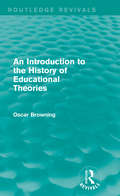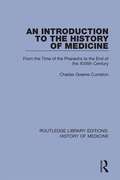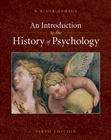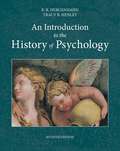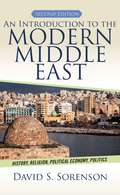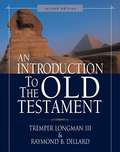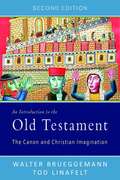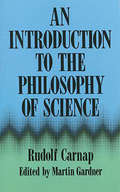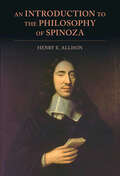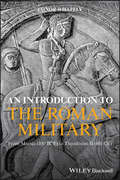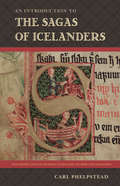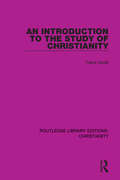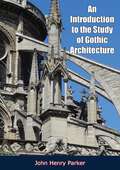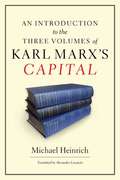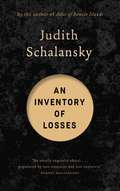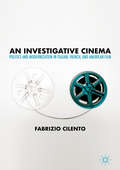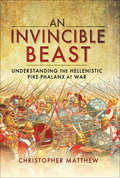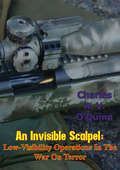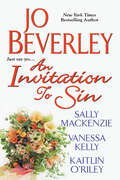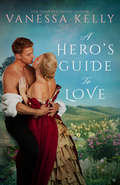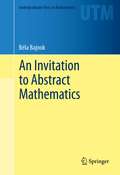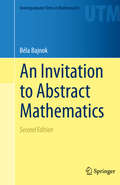- Table View
- List View
An Introduction to the History of Educational Theories (Routledge Revivals)
by Oscar BrowningAn Introduction to the History of Educational Theories, first published in 1881, offers a comprehensive overview of the most notable approaches to education throughout Western history, from Athens and Rome to the Victorian public school. Exploring not only the still famous theories of Plato and Aristotle, this work also touches on techniques in education which are either no longer prevalent – Roman Oratory, the Jesuits – or in some cases were never widely adopted or appreciated: John Milton, for example. This title will be of value to those intrigued by the potential of past attitudes for present-day application, as well as to those unconvinced by contemporary approaches.
An Introduction to the History of Medicine: From the Time of the Pharaohs to the End of the XVIIIth Century (Routledge Library Editions: History of Medicine #3)
by Charles Greene CumstonOriginally published in 1926, An Introduction to the History of Medicine is a compilation of reliable and essential contributions to the subject of the history of medicine. The book looks at the evolution of medicine from the practices in Ancient Egypt, to the medicine of the 16th century, and examines the work of Hippocrates and Galen. The book also examines the philosophy that began around the practice of medicine, as well as early discussions of ethics. It also looks at early medicine through the lens of religion, covering the practices of medicine in Hindu, Chaldean and Islamic religions. The book provides a broad coverage of early medicine in ancient civilizations, focusing particularly on Ancient Greece, Persia and Rome.
An Introduction to the History of Psychology
by B. R. HergenhahnThis textbook traces the history of psychology from the ancient Greeks to the present, with chapters discussing the major schools of thought, important developments, and the contributions of particular theorists. Among those discussed are Aristotle, empiricism and positivism, rationalism, romanticism and existentialism, the rise of experimental psychology, the rise of mental testing, functionalism, behaviorism, Gestalt psychology, psychoanalysis, humanistic psychology, psychobiology, and cognitive psychology. Hergenhahn taught at Hamline University. Annotation ©2004 Book News, Inc., Portland, OR (booknews.com)
An Introduction to the History of Psychology
by B. R. Hergenhahn Tracy HenleyDreams puzzled early man, Greek philosophers spun elaborate theories to explain human memory and perception, Descartes postulated that the brain was filled with "animal spirits," and psychology was officially deemed a "science" in the 19th century. In this Seventh Edition of AN INTRODUCTION TO THE HISTORY OF PSYCHOLOGY, authors Hergenhahn and Henley demonstrate that most of the concerns of contemporary psychologists are manifestations of themes that have been part of psychology for hundreds--or even thousands--of years. The book's numerous photographs and pedagogical devices, along with its biographical material on key figures in psychology, engage readers and facilitate their understanding of each chapter. Available with InfoTrac Student Collections http://gocengage. com/infotrac.
An Introduction to the Modern Middle East
by David S. SorensonCombining elements of comparative politics with a country-by-country analysis, author David S. Sorenson provides a complete and accessible introduction to the modern Middle East. With an emphasis on the politics of the region, the text also dedicates chapters specifically to the history, religions, and economies of countries in the Persian (Arabian) Gulf, the Eastern Mediterranean, and North Africa. In each country chapter, a brief political history is followed by discussions of democratization, religious politics, women's issues, civil society, economic development, privatization, and foreign relations. In this updated and revised second edition, An Introduction to the Modern Middle East includes new material on the Arab Spring, the changes in Turkish politics, the Iranian nuclear issues, and the latest efforts to resolve the Israeli-Palestinian dilemma. Introductory chapters provide an important thematic overview for each of the book's individual country chapters and short vignettes throughout the book offer readers a chance for personal reflection.
An Introduction to the New Testament and the Origins of Christianity
by Delbert BurkettThis book offers an authoritative and accessible introduction to the New Testament and early Christian literature for all students of the Bible and anyone interested in the origins of Christianity. It is designed primarily for undergraduate courses in the New Testament, biblical studies and early Christianity. There are questions for in-class discussion and written assignment, step-by-step reading guides on individual works, special box features, charts, maps and numerous illustrations designed to facilitate student use. With this textbook and the Bible, the student should therefore have all the necessary basic texts.
An Introduction to the Old Testament: Second Edition
by Tremper Longman IIIAn upper-level introduction to the Old Testament that offers students a thorough understanding of three key issues: historical background, literary analysis, and theological message.This second edition of An Introduction to the Old Testament integrates recent developments in Old Testament scholarship. It has many distinctive features that set it apart from other introductions to the Old Testament:It's committed to a theologically evangelical perspective.Emphasizes "special introduction"—the study of individual books.Interacts in an irenic spirit with the historical-critical method.Features points of research history and representative scholars rather than an exhaustive treatment of past scholarship.Deals with the meaning of each book, not in isolation but in a canonical context.Probes the meaning of each book in the setting of its culture.Including callouts, charts, and graphs, An Introduction to the Old Testament is written with an eye to understanding the nature of Old Testament historiography.Perfect for seminary students, professors, and Bible teachers and ministry leaders, as well as anyone looking for an in-depth and balanced approach to Old Testament study.
An Introduction to the Old Testament: The Canon and Christian Imagination (Second Edition)
by Walter Brueggemann Tod LinafeltIn this updated edition of the popular textbook, Walter Brueggemann and Tod Linafelt introduce the reader to the broad theological scope of the Old Testament, treating some of the most important issues and methods in contemporary biblical interpretation. This clearly written textbook focuses on the literature of the Old Testament as it grew out of religious, political, and ideological contexts over many centuries in Israel's history. Covering every book in the Old Testament (arranged in canonical order), the authors demonstrate the development of theological concepts in biblical writings from the Torah through post-exilic Judaism. This introduction invites readers to engage in the construction of meaning as they venture into these timeless texts.
An Introduction to the Philosophy of Mathematics
by Mark ColyvanThis introduction to the philosophy of mathematics focuses on contemporary debates in an important and central area of philosophy. The reader is taken on a fascinating and entertaining journey through some intriguing mathematical and philosophical territory, including such topics as the realism/anti-realism debate in mathematics, mathematical explanation, the limits of mathematics, the significance of mathematical notation, inconsistent mathematics and the applications of mathematics. Each chapter has a number of discussion questions and recommended further reading from both the contemporary literature and older sources. Very little mathematical background is assumed and all of the mathematics encountered is clearly introduced and explained using a wide variety of examples. The book is suitable for an undergraduate course in philosophy of mathematics and, more widely, for anyone interested in philosophy and mathematics.
An Introduction to the Philosophy of Science
by Rudolf CarnapOne of the most creative philosophers of the 20th century, Rudolf Carnap presented a series of science lectures at the University of California in 1958. The present volume is an outgrowth of that seminar, which dealt with the philosophical foundations of physics. Edited by Martin Gardner from transcripts of Carnap's classroom lectures and discussions, the book remains one of the clearest and soundest introductions to the philosophy of science.Specially designed to appeal to a wide range of readers, An Introduction to the Philosophy of Science offers accessible coverage of such topics as laws and probability, measurement and quantitative language, the structure of space, causality and determinism, theoretical laws and concepts and much more. Stimulating and thought-provoking, the text will be of interest to philosophers, scientists and anyone interested in logical analysis of the concepts, statements and theories of science. Foreword to the Basic Books Paperback Edition, 1974 (Gardner); Preface (Carnap); Foreword to the Dover Edition (Gardner). 35 black-and-white illustrations. Bibliography.
An Introduction to the Philosophy of Spinoza
by Henry E. AllisonAimed at those new to studying Spinoza, this book provides a comprehensive introduction to his thought, placing it in its historical and philosophical contexts, and assessing its critical reception. In addition to providing an analysis of Spinoza's metaphysical, epistemological, psychological, and ethical views in the Ethics, Henry Allison also explores his political theory and revolutionary views on the Bible, as well as his account of Judaism, which led to the excommunication of the young Spinoza from the Jewish community in Amsterdam. Although the book's main focus is on the analysis of Spinoza's views, including a close reading of the central arguments of the Ethics, it also considers many of the standard objections to these arguments as well as possible responses to them. This completely revised and updated new edition of Allison's classic book, with two new chapters, will help a new generation of students to understand and value Spinoza's work.
An Introduction to the Roman Military: From Marius (100 BCE) to Theodosius II (450 CE)
by Conor WhatelyFollows the military lives of three soldiers across the Roman world, providing interesting, historical insight into the Roman military from the late republic to the end of antiquity in the west This book introduces readers to three historical Roman soldiers—Titus Pullo from the late republic, Aurelius Polion from the high imperial era, and Flavius Aemilianus from late antiquity. The three men inspire the themes and chronological organization of the text. Drawing on a wide and diverse body of evidence, the author charts their lives from enlistment to death or retirement, allowing students to envision the life of a Roman soldier who is on duty or experiencing adventures across the Roman world. An Introduction to the Roman Military: From Marius (100 BCE) to Theodosius II (450 CE) starts with a historical overview before introducing readers to the Roman soldier. It covers such things as the military hierarchy, soldierly origins, recruitment and training, and the soldier’s appearance and identity. The next section looks at the Roman military during war—its environment, strategies, campaigns, and enemies. Their existence during times of peace follows that and focuses on how soldiers celebrated victory, mourned defeat, and readjusted to civilian life after a war. The book also features a timeline for readers to follow, as well as two glossaries—one filled with Roman military terms and the other with important names and events. · Authentically captures the experiences of Roman soldiers · Educates undergraduate or graduate students on Roman military history · Describes Roman soldiers based on legal, epigraphic, and archaeological evidence · Emphasizes the human side of the Roman military · Moves through three Roman historical periods—the late republic, high imperial, and late antiquity An Introduction to the Roman Military is an engaging choice as a text for specific courses on the Roman military or army. It is also suitable for more general courses covering ancient warfare. In addition to university students, researchers and history enthusiasts will have the opportunity to follow the military lives of three Roman soldiers with this unique book.
An Introduction to the Sagas of Icelanders (New Perspectives on Medieval Literature: Authors and Traditions)
by Carl PhelpsteadCombining an accessible approach with innovative scholarship, An Introduction to the Sagas of Icelanders provides up-to-date perspectives on a unique medieval literary genre that has fascinated the English-speaking world for more than two centuries. Carl Phelpstead draws on historical context, contemporary theory, and close reading to deepen our understanding of Icelandic saga narratives about the island’s early history. Phelpstead explores the origins and cultural setting of the genre, demonstrating the rich variety of oral and written source traditions that writers drew on to produce the sagas. He provides fresh, theoretically informed discussions of major themes such as national identity, gender and sexuality, and nature and the supernatural, relating the Old Norse-Icelandic texts to questions addressed by postcolonial studies, feminist and queer theory, and ecocriticism. He then presents readings of select individual sagas, pointing out how the genre’s various source traditions and thematic concerns interact. Including an overview of the history of English translations that shows how they have been stimulated and shaped by ideas about identity, and featuring a glossary of critical terms, this book is an essential resource for students of the literary form. A volume in the series New Perspectives on Medieval Literature: Authors and Traditions, edited by R. Barton Palmer and Tison Pugh
An Introduction to the Study of Christianity
by Frank DoddOriginally published in 1938, An Introduction to the Study of Christianity is a consideration of what is truly essential in the Christian faith. The book provides a detailed survey of key elements relating to the origin and growth of Christianity, and puts forward the argument that any apparent blemishes or mistakes are the result of human imperfection and misunderstanding of the real teaching of Jesus and his immediate followers, rather than of any shortcomings in the teaching itself. It first sets out the foundations of Christianity and then calls attention to the different interpretations that successive generations of Christians have placed on them. Exploring the history of the Christian faith up to the 1930s, An Introduction to the Study of Christianity will appeal to those with an interest in the history of religion, Christianity, theology, and religious studies.
An Introduction to the Study of Gothic Architecture
by John Henry ParkerThis popular and important textbook of Gothic architecture, first published in 1849, which ran to at least sixteen editions. The book is divided into the main body of the text, with mostly English examples of the various periods, and a section on foreign styles (French Gothic, Italian, Spanish, Swiss, Belgian, German).-Print ed.John Henry Parker CB (1 March 1806 – 31 January 1884) was an English archaeologist and writer on architecture and publisher.He was born in London, the son of John Parker, a merchant there. He was educated at Manor House School, Chiswick, and was apprenticed in 1821 to his uncle, the Oxford bookseller Joseph Parker (1774?–1850). He succeeded to his uncle's business in 1832, and ran the firm with great success, the most important of his publications being perhaps the series of the Oxford pocket classics.In 1836 he published his Glossary of terms used in Grecian, Roman, Italian, and Gothic architecture, which, published during the Gothic Revival in England, had considerable influence in extending the movement, and supplied valuable inspiration to young architects. In 1848 he edited the fifth edition of Thomas Rickman's Gothic architecture, and in 1849 he published a handbook based on his earlier volume entitled Introduction to the study of Gothic architecture. The completion of Hudson Turner's Domestic architecture of the Middle Ages next engaged his attention, three volumes being published (1853–60). He published Medieval architecture of Chester in 1858 and Architectural antiquities of the city of Wells in 1866.Parker was one of the chief advocates of the restoration of ecclesiastical buildings. In 1863 he and the Oxford Diocesan Architect G.E. Street revised plans for the restoration of St. Andrew's parish church, Chinnor. Parker also designed the triplet of traceried lancet windows in the chancel of St. Nicholas the Confessor, Forest Hill. His son James Parker (1832 or 1833–1912) also practiced as an architect.
An Introduction to the Three Volumes of Karl Marx's Capital
by Michael Heinrich Alex LocascioThe global economic crisis and recession that began in 2008 had at least one unexpected outcome: a surge in sales of Karl Marx's Capital. Although mainstream economists and commentators once dismissed Marx's work as outmoded and flawed, some are begrudgingly acknowledging an analysis that sees capitalism as inherently unstable. And of course, there are those, like Michael Heinrich, who have seen the value of Marx all along, and are in a unique position to explain the intricacies of Marx's thought. Heinrich's modern interpretation of Capital is now available to English-speaking readers for the first time. It has gone through nine editions in Germany, is the standard work for Marxist study groups, and is used widely in German universities. The author systematically covers all three volumes of Capital and explains all the basic aspects of Marx's critique of capitalism in a way that is clear and concise. He provides background information on the intellectual and political milieu in which Marx worked, and looks at crucial issues beyond the scope of Capital, such as class struggle, the relationship between capital and the state, accusations of historical determinism, and Marx's understanding of communism. Uniquely, Heinrich emphasizes the monetary character of Marx's work, in addition to the traditional emphasis on the labor theory of value, this highlighting the relevance of Capital to the age of financial explosions and implosions.
An Inventory of Losses: LONGLISTED FOR THE INTERNATIONAL BOOKER PRIZE 2021
by Judith Schalansky"A fine example of everyone's favourite genre: the genre-defying book, inspired by history, filtered through imagination and finished with a jeweller's eye for detail" JOHN SELF, Guardian"As we deal with the consequences, emotional and material, of a pandemic, it is hard to imagine a better guide to the resources of hope than Schalansky's deeply engaging inventory" MICHAEL CRONIN, Irish Times"Weaving fiction, autobiography and history, this sumptuous collection of texts offers meditations on the diverse phenomena of decomposition and destruction" Financial Times "Books of the Year""Pure gold storytelling" SJONJudith Schalansky's strange and wonderful new book, recalling writers as different as W.G. Sebald and Christa Wolf, Joan Didion and Rebecca Solnit, sees her return to the territory she explored so successfully with her best-selling Atlas of Remote Islands: Fifty Islands I Have Never Set Foot On and Never Will, which Robert MacFarlane called "utterly exquisite" (Guardian) and about which Time Out's reviewer said "Rarely has armchair travel been so farflung and romantic".Judith Schalansky is a wholly original writer whose books articulate perfectly what she wishes to say. Each of the pieces, following the conventions of a different genre, considers something that is irretrievably lost to the world, including the paradisal pacific island of Tuanaki, the Caspian Tiger, the Villa Sacchetti in Rome, Sappho's love poems, Greta Garbo's fading beauty, a painting by Caspar David Friedrich, and the former East Germany's Palace of the Republic. As a child of the former East Germany, it's not surprising that the dominant emotion in Schalansky's work should be "loss" and its aftermath, but what is extraordinary is the thoroughly engaging mixture of intellectual curiosity, down-to-earth grasp of life's pitiless vitality, ironic humour, stylistic elegance and intensity of feeling that combine to make this book a masterpiece and one of the most original and beautifully designed books to be published in 2020.Translated from the German by Jackie Smith
An Investigation of Some Macro-Financial Linkages of Securitization
by Andreas Jobst Mangal Goswami Xin LongA report from the International Monetary Fund.
An Investigative Cinema: Politics and Modernization in Italian, French, and American Film
by Fabrizio CilentoThis book traces the development of investigative cinema, whose main characteristic lies in reconstructing actual events, political crises, and conspiracies. These documentary-like films refrain from a simplistic reconstruction of historical events and are mainly concerned with what does not immediately appear on the surface of events. Consequently, they raise questions about the nature of the “truth” promoted by institutions, newspapers, and media reports. By highlighting unanswered questions, they leave us with a lack of clarity, and the questioning of documentation becomes the actual narrative. Investigative cinema is examined in relation to the historical conjunctures of the “economic miracle” in Italy, the simultaneous decolonization and reordering of culture in France, the waves of globalization and neoliberalism in post-dictatorial Latin America, and the post-Watergate, post-9/11 climate in US society. Investigative cinema is exemplified by the films Salvatore Giuliano, The Battle of Algiers, The Parallax View, Gomorrah, Zero Dark Thirty, and Citizenfour.
An Invincible Beast: Understanding the Hellenistic Pike Phalanx in Action
by Christopher MatthewThe Hellenistic pike-phalanx was a true military innovation, transforming the face of warfare in the ancient world. For nearly 200 years, from the rise of the Macedonians as a military power in the mid-fourth century BC, to their defeat at the hands of the Romans at Pydna in 168BC, the pike-wielding heavy infantryman (the phalangite) formed the basis of nearly every Hellenistic army to deploy on battlefields stretching from Italy to India. And yet, despite this dominance, and the vast literature dedicated to detailing the history of the Hellenistic world, there remains fierce debate among modern scholars about how infantry combat in this age was actually conducted.Christopher Matthews critically examines phalanx combat by using techniques such as physical re-creation, experimental archaeology, and ballistics testing, and then comparing the findings of this testing to the ancient literary, artistic and archaeological evidence, as well as modern theories. The result is the most comprehensive and up-to-date study of what heavy infantry combat was like in the age of Alexander the Great and his successors.
An Invisible Scalpel: Low-Visibility Operations in the War on Terror
by Charles R. V. O’QuinnThe War on Terror (WOT) is actually a war against extremist insurgents comprised of numerous and varied organizations scattered across the globe. They are spurred to action by an extremist ideology that is nurtured, demonstrated, and led by al Qaeda and its leadership. This ideology serves as the insurgency's center of gravity whereby it gains all manner of support across a broad spectrum of functional resources in multiple operational domains. As operating environments change, these ideology inspired decentralized insurgent organizations are able to quickly adapt their methods of operation. In order to defeat this evolving, ubiquitous yet elusive threat, the US must develop a comprehensive strategy that incorporates all instruments of US national power, as well as those of its allies. This strategy must also defeat or mitigate the enemy's center of gravity in order to have any chance of success. This thesis argues that as lead combatant command in the WOT, the US Special Operations Command (USSOCOM) should conduct continuous, global, pre-emptive low-visibility operations in order to disrupt insurgent operations. In order to accomplish its WOT missions, USSOCOM must effectively organize and array forces and resources to defeat insurgent functional resources across multiple operational domains.
An Invitation To Sin
by Jo Beverley Kaitlin O'Riley Vanessa Kelly Sally MacKenzieThe game of love is filled with scandals and secrets in this quartet of Regency tales featuring New York Times– and USA Today–bestselling authors. Romance can blossom with little provocation and even less consideration for what&’s good and proper. But when a spark ignites, it can be far too tempting to ignore—no matter how shocking the pairing may be . . . &“Forbidden Attractions&” by Jo Beverley When the notorious Earl of Carne moves into the mansion adjoining Anna Featherstone&’s London townhouse, they&’re separated by a single wall—and a gulf of social disdain. But sometimes the strangest neighbors can make the most intriguing of friends . . . &“The Naked Prince&” by Sally MacKenzie Josephine Atworthy is a proper and studious lady, and, as such, has no time for debauched goings on. But when she winds up on the guest list of one of her rich neighbor&’s parties, she&’s too intrigued to turn down the invitation—and far too attracted to the mysterious nobleman who seems desperate for just one kiss . . . &“The Pleasure of a Younger Lover&” by Vanessa Kelly After youthful friendship turns into ardent, grown-up passion, Clarissa Middleton and Captain Christian Archer find it difficult to keep their thoughts—or kisses—to themselves. But the differences between them might be too great for London society to overcome . . . &“A Summer Love Affair&” by Kaitlin O&’Riley Nothing is quite so intoxicating as a holiday abroad in the sultry sun of Spain. That is, until Miss Charlotte Wilson discovers the irresistible charm of Mr. Gavin Ellsworth and embarks on a most enjoyable—and revealing—fling.
An Invitation To Sin
by Vanessa KellyForbidden Affections by Jo BeverleyThe doors to romance can be found in the most unexpected places, especially when the notorious Earl of Carne moves into the mansion neighboring Anna Featherstone's London townhouse. Who knocks first remains the only question. . .The Pleasure Of A Younger Lover by Vanessa KellyClarissa Middleton cannot resist the ardent kisses of Captain Christian Archer, though they must meet in secret or risk the censure of London society. In each other's arms, desire and love melt two hearts into one. . .The Naked Prince by Sally MacKenzieJosephine Atworthy is shocked by the goings-on at her rich neighbor's house party. Quite shocked. But her demure charm beguiles a mysterious nobleman, who begs a kiss--then another. And in a twinkling they fall head over heels in love. . . A Summer Love Affair by Kaitlin O'RileyUnmarried. Unconventional. Unchaperoned. Miss Charlotte Wilson is free to do as she pleases and Gavin Ellsworth is dashing. Summer in Spain at a secluded villa is about to get a whole lot hotter. . .
An Invitation to Abstract Mathematics (Undergraduate Texts in Mathematics)
by Béla BajnokThis undergraduate textbook is intended primarily for a transition course into higher mathematics, although it is written with a broader audience in mind. The heart and soul of this book is problem solving, where each problem is carefully chosen to clarify a concept, demonstrate a technique, or to enthuse. The exercises require relatively extensive arguments, creative approaches, or both, thus providing motivation for the reader. With a unified approach to a diverse collection of topics, this text points out connections, similarities, and differences among subjects whenever possible. This book shows students that mathematics is a vibrant and dynamic human enterprise by including historical perspectives and notes on the giants of mathematics, by mentioning current activity in the mathematical community, and by discussing many famous and less well-known questions that remain open for future mathematicians. Ideally, this text should be used for a two semester course, where the first course has no prerequisites and the second is a more challenging course for math majors; yet, the flexible structure of the book allows it to be used in a variety of settings, including as a source of various independent-study and research projects.
An Invitation to Abstract Mathematics (Undergraduate Texts in Mathematics)
by Béla BajnokThis undergraduate textbook promotes an active transition to higher mathematics. Problem solving is the heart and soul of this book: each problem is carefully chosen to demonstrate, elucidate, or extend a concept. More than 300 exercises engage the reader in extensive arguments and creative approaches, while exploring connections between fundamental mathematical topics.Divided into four parts, this book begins with a playful exploration of the building blocks of mathematics, such as definitions, axioms, and proofs. A study of the fundamental concepts of logic, sets, and functions follows, before focus turns to methods of proof. Having covered the core of a transition course, the author goes on to present a selection of advanced topics that offer opportunities for extension or further study. Throughout, appendices touch on historical perspectives, current trends, and open questions, showing mathematics as a vibrant and dynamic human enterprise.This second edition has been reorganized to better reflect the layout and curriculum of standard transition courses. It also features recent developments and improved appendices. An Invitation to Abstract Mathematics is ideal for those seeking a challenging and engaging transition to advanced mathematics, and will appeal to both undergraduates majoring in mathematics, as well as non-math majors interested in exploring higher-level concepts.From reviews of the first edition:Bajnok’s new book truly invites students to enjoy the beauty, power, and challenge of abstract mathematics. … The book can be used as a text for traditional transition or structure courses … but since Bajnok invites all students, not just mathematics majors, to enjoy the subject, he assumes very little background knowledge. Jill Dietz, MAA ReviewsThe style of writing is careful, but joyously enthusiastic…. The author’s clear attitude is that mathematics consists of problem solving, and that writing a proof falls into this category. Students of mathematics are, therefore, engaged in problem solving, and should be given problems to solve, rather than problems to imitate. The author attributes this approach to his Hungarian background … and encourages students to embrace the challenge in the same way an athlete engages in vigorous practice. John Perry, zbMATH
